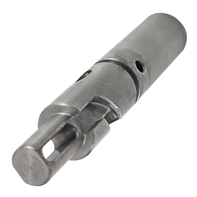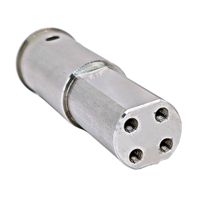- All
- Product Name
- Product Keyword
- Product Model
- Product Summary
- Product Description
- Multi Field Search


Views: 0 Author: Site Editor Publish Time: 2025-06-06 Origin: Site













Modern energy systems—from large thermal power plants to solar farms and microgrids—operate under demanding conditions. High temperatures, elevated pressures, corrosive fluids, particulate contamination, and continuous vibration challenge every component. Electric valves, driven by electric motors rather than manual or pneumatic means, have become indispensable. They provide precise, repeatable control over fluid flow, enabling automated control loops and remote operation. Yet, to perform reliably, electric valves must be engineered with rigorous material selection, advanced sealing, and effective pressure‐balancing. This article examines why electric valves are crucial for energy system reliability, focusing on how body materials, seal technologies, corrosion protections, and cavity designs contribute to long‐term performance.
The valve body must withstand mechanical and chemical stresses. Common materials include stainless steel, cast steel, aluminum alloys, and composite plastics—each balancing strength, corrosion resistance, temperature tolerance, and cost.
Corrosion Resistance: Grades 304 and 316L resist rust and general corrosion in water, steam, and mildly acidic environments. In seawater desalination and power plant condensate cycles, 316L’s molybdenum improves resistance against chlorides and pitting.
High‐Temperature Strength: Both grades maintain strength up to ~400 °C, critical where valves handle high‐pressure steam. Their smooth surfaces discourage scale, facilitating cleaning.
Stainless steel bodies cost more than carbon steel. In highly acidic or saline conditions, more exotic alloys may be needed.
High Strength and Cost‐Effectiveness: WCB (carbon steel) and LCB (low‐temperature carbon steel) handle pressures up to 4,000 psi (≈275 bar) at moderate temperatures (~350 °C). These grades dominate steam, feedwater, and condensate valves.
Weldability: Carbon steel bodies can be field‐welded, simplifying repairs in coal‐fired plants or flue gas desulfurization systems.
Without protective coatings, carbon steel corrodes quickly in acidic or saline environments. Lined or coated valves mitigate this risk but add cost.
Lightweight for Low‐Pressure Use: Aluminum alloys (e.g., 6061‐T6) serve low‐pressure, low‐temperature loops—like solar thermal recirculation or chilled water systems—where weight and cost matter. Their high thermal conductivity helps dissipate heat in cyclical applications.
Plastic Composites: Reinforced polypropylene (PP), PVC, or FRP handle corrosive chemicals in acid dosing or scrubber blowdown lines, but only up to ~150 psi and ~80 °C.
Aluminum and plastic valves are unsuitable for high‐pressure, high‐temperature core processes; they excel in peripheral roles.
Selecting proper sealing materials and packing ensures leak‐free performance under pressure, temperature swings, and chemical attack. Valve designers choose polymers and graphite packing based on compatibility, temperature range, and cycle frequency.
Chemical Inertness: PTFE resists nearly all acids, bases, solvents, and many oxidizers. In condensate lines or flue gas scrubbers, PTFE seats and O-rings handle corrosive fluids without degradation.
Low Friction: Reduced stem torque allows smaller motors and gearboxes—ideal for throttling valves in feedwater control.
Wide Temperature Range: PTFE remains stable from –50 °C to 260 °C, suitable for steam service and sampling valves.
PTFE’s drawback is “cold flow” (creep) under sustained high pressure. Spring‐energized or filled PTFE combats this, improving stability.
High‐Temperature Elasticity: FKM (Viton®) and silicone remain flexible at up to ~200 °C, ideal for steam mixing and hot oil loops in combined‐cycle plants.
Oil and Fuel Resistance: FKM resists hydrocarbon degradation, suitable for gas turbine fuel shutoff valves and lubrication skids.
Compression Set Resistance: Silicone maintains elasticity over thousands of cycles, beneficial in solar thermal valve assemblies.
These elastomers deteriorate under strong acid or alkali exposure, so PTFE or graphite is preferred for extreme pH conditions.
High‐Temperature Capability: Flexible graphite withstands temperatures above 300 °C, essential for superheated steam or hot oil valves. In turbine stop valves and superheater vents, graphite packing conforms to stem movement while sealing.
Self‐Lubrication: Graphite reduces stem friction, extending packing life in high‐flow or erosive service.
Graphite packing requires periodic tightening, adding maintenance complexity. Modern formulations blend graphite with synthetic fibers (e.g., aramid) to resist oxidation.
Valve stems and connectors, exposed to corrosive or particulate‐laden fluids, must resist erosion and corrosion. Surface treatments extend service life and prevent binding.
Surface Hardness and Corrosion Resistance: Nickel plating (10–20 μm) raises hardness to >400 HV, protecting against abrasion. Hard chrome plating (up to 50 μm) pushes hardness to ~700 HV, ideal for high‐cycle throttling valves in feedwater service.
Reduced Galling: Plated stems avoid cold welding when rubbing against stainless steel nuts, preventing seizing in sediment‐laden flows.
Uniform, defect‐free plating is essential; poor adhesion leads to flaking and rapid failure.
Anodizing (Al₂O₃ Layer): Thickens aluminum's oxide layer (up to ~25 μm), raising hardness to ~200 HV and improving corrosion resistance. Anodized stems in chilled water valves remain rust‐free for years.
Shot Peening: Imparts compressive surface stress, enhancing fatigue life—critical in vibrating solar tracker valves.
Anodic coatings degrade above ~100 °C, limiting their use in hotter loops.

Unbalanced pressure forces on valve plugs or discs can demand excessive actuator torque and cause rapid wear. Effective balancing and sealing cavity design minimize these forces.
Pressure‐Equalizing Passages: Globe and angle valves often include pilot holes that channel upstream fluid behind the plug, reducing net pressure differential. This balanced design can halve the torque required, enabling smaller actuators in high‐pressure feedwater valves.
Double‐Seat Balanced Valves: Three‐way mixing valves in district heating use opposed seats sharing upstream pressure. When the plug centers, upstream forces cancel, reducing required closing torque. This allows precise temperature control with compact actuators.
Balanced valves excel in high‐pressure steam service, preventing the need for oversized, costly actuators.
Dual Lip Seals: A cartridge with two consecutive lip seals—often PTFE over FKM—provides redundancy. If the primary seal leaks, the secondary prevents flow, crucial for hydrogen or natural gas isolation.
Backup Rings: Prevent PTFE seal extrusion under high pressure. Rigid rings (PEEK or filled PTFE) back up the softer seal, enabling long service life even when pressures fluctuate rapidly.
Combining these features yields predictable torque requirements and reliable shutoff, simplifying actuator sizing.
Electric valves are vital for the reliability of modern energy systems. They deliver precise, automated fluid control across diverse applications—steam turbines, solar thermal loops, microgrids, and more. To ensure continuous, leak‐free operation under harsh conditions, take the following steps:
Match Body Material to Fluid and Temperature:
Use stainless steel (304/316L) for seawater, acidic condensate, and moderate‐temperature steam—resistant to corrosion and scale.
Specify cast steel (WCB/LCB) for high‐pressure, moderate‐temperature data circuits—affordable and robust.
Deploy aluminum alloys or plastics for low‐pressure, low‐temperature hydronic loops—lightweight and cost‐effective.
Choose Advanced Sealing Materials:
PTFE for wide chemical compatibility (–50 °C to 260 °C).
FKM (Viton) or Silicone for high‐cycle flexibility and moderate steam temperatures (up to 200 °C).
Graphite/Carbon Fiber Packing for high‐temperature (300 °C+) steam or hot oil—self‐lubricating and conformable.
Protect Stems and Hardware:
Nickel or Hard Chrome Plating to resist abrasion and galling in sediment‐laden service.
Anodizing and Shot Peening on aluminum stems for corrosion resistance and enhanced fatigue life in vibrating environments.
Ensure Pressure Balancing:
Pilot Holes or Double‐Seat Configurations reduce unbalanced forces, allowing smaller actuators.
Dual Seals and Backup Rings to prevent extrusion and maintain tight shutoff under high pressures.
By integrating these measures, engineers can avoid valve failures that would otherwise cause unplanned shutdowns, safety incidents, or diminished efficiency. For best results, conduct corrosion and thermal tests with actual process fluids to validate choices in materials and sealing systems.
Shenzhen Wandaan Precision Technology Co., Ltd. stands ready to supply electric valves tailored to energy industry demands. Their offerings include:
Custom Valve Body Fabrication: Machined from 316L stainless, WCB cast steel, or aluminum alloys.
Specialized Seal Packages: PTFE, FKM, and graphite packings matched to fluid chemistry and temperature.
Surface Treatments: Nickel‐plating, chrome‐plating, and anodizing for stems and wear parts.
Integrated Actuator Assemblies: Electric actuators with feedback, torque sensors, and fast‐acting motors for both modulating and on/off service.
Partnering with Wandaan ensures valves arrive fully tested—hydrostatically, pneumatically, and functionally—ready for seamless integration into your DCS or SCADA system. Their commitment to ISO 9001 quality control guarantees each valve meets international standards, delivering reliability, safety, and long service life.
In summary, electric valves engineered with optimal materials, seals, and pressure‐balancing designs are essential for reliable, efficient modern energy systems. Early collaboration with a specialist like Shenzhen Wandaan ensures you specify valves that perform flawlessly under your plant’s unique conditions, safeguarding continuous operation and minimizing lifecycle costs.